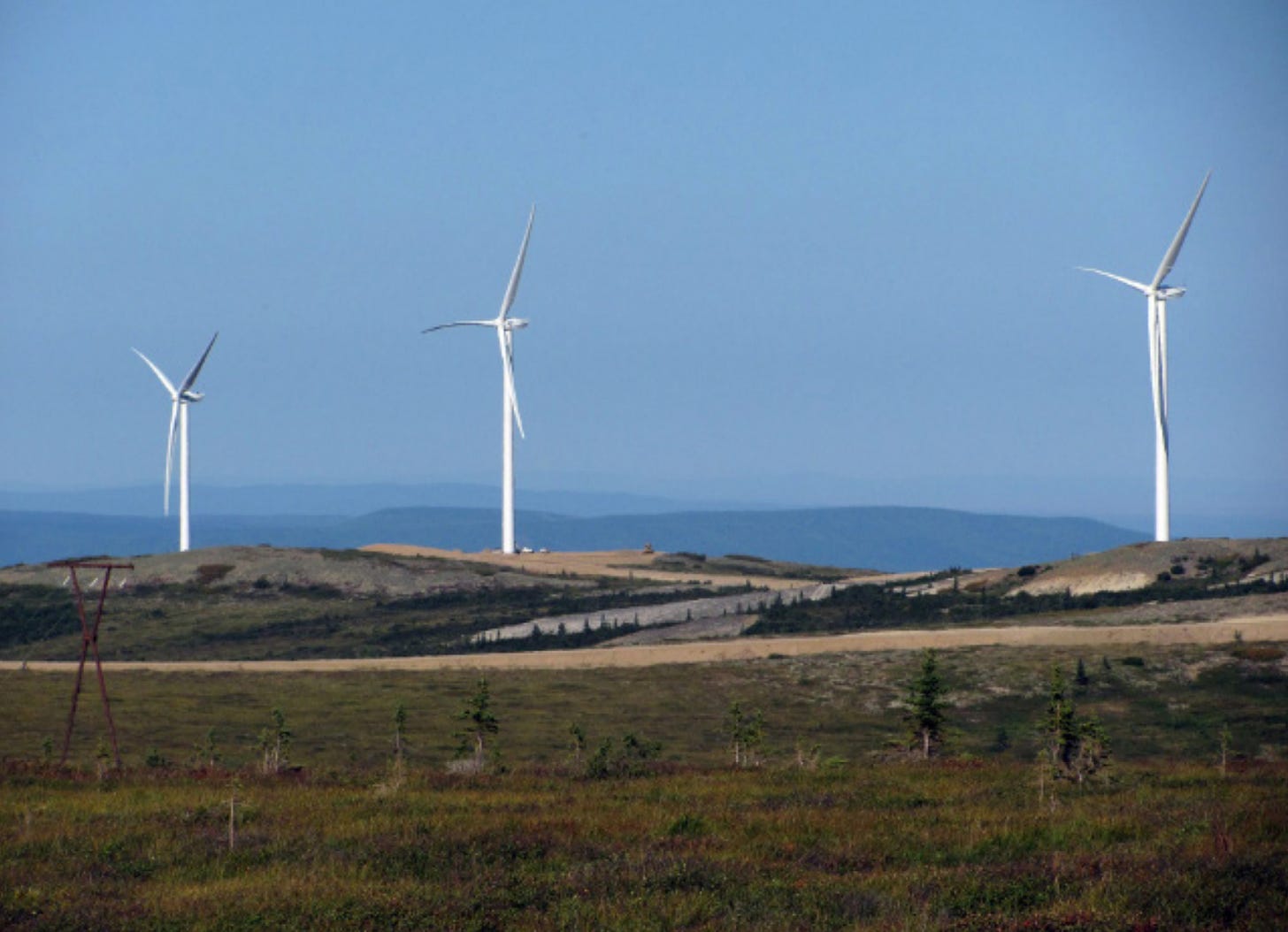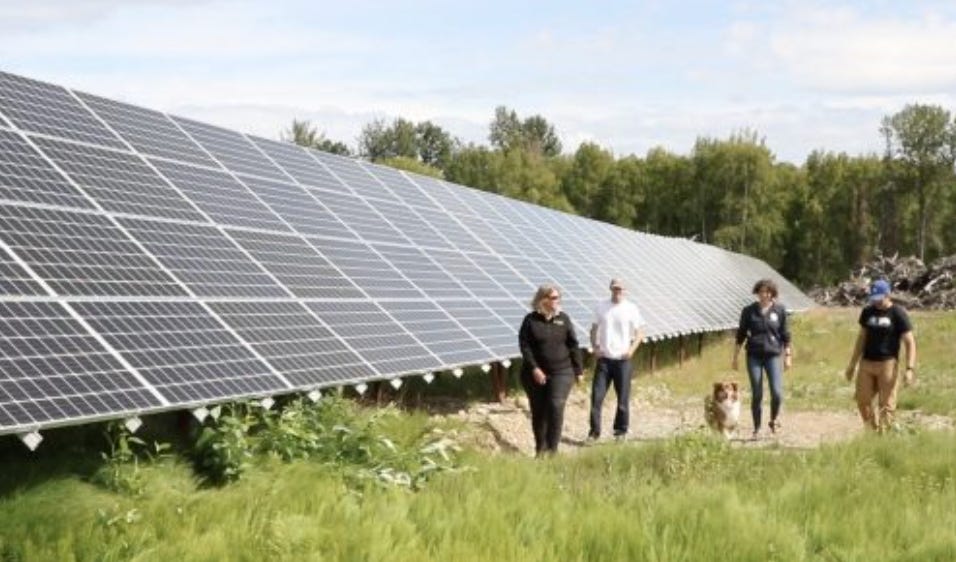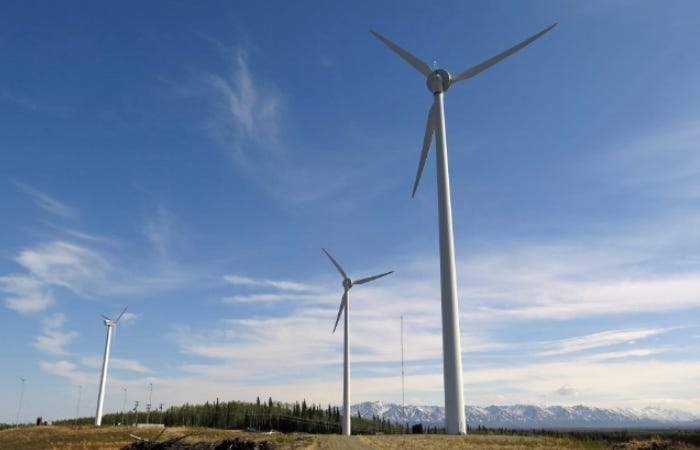As natural gas shortage looms, Alaska electric utilities and advocates are feuding over a renewable power bill
The two sides agree on the need to wean Alaska’s power grid from its deep dependence on natural gas. But they disagree sharply about how quickly the transition should happen, and potential costs.

Even before Alaska GOP Gov. Mike Dunleavy unveiled a bill to require the state’s utilities to generate more power from renewable sources, executives were springing into action.
Four months before Dunleavy introduced his legislation, the state official who would be responsible for pushing it was already hearing from utility leaders who were worried the governor’s goal — 80% renewable power by 2040 — was too ambitious and was taken out of an advocacy group’s playbook.
“I’m really alarmed and seeking your thoughts on this,” Tony Izzo, chief executive of Matanuska Electric Association, the big electrical cooperative in the Mat-Su, wrote in his email to Curtis Thayer, head of the Alaska Energy Authority.
Utilities, Izzo said in a follow-up email, were told that Dunleavy supports the 80% target “because it was developed by a broad group of stakeholders. Not true!!!”
Izzo’s emails, disclosed in response to a public records request, offer a glimpse into the simmering feud over the proposal to establish what’s known as a “renewable portfolio standard,” or RPS. That fight has taken place in public and in private over the past year, as proposals from Dunleavy and individual lawmakers have languished at the Capitol until a flurry of hearings recently.
The two sides of the dispute agree on the need to wean Alaska’s power grid from its deep dependence on natural gas — particularly given warnings of an impending depletion of local gas supplies. But they disagree sharply about how quickly the transition should happen, and whether a government mandate to install more renewable power sources will benefit consumers.
On one side are Alaska’s urban electrical cooperatives and their allies, who say the utilities are already working diligently to bring on new wind, solar and hydroelectric power projects. They say there’s no need to force the utilities to work more quickly — and they add that rushing into new projects could raise electricity rates.
“I don’t think that, if legislation had passed last year, we would be moving any faster,” said Julie Estey, who works with Izzo at the Mat-Su utility.
On the other side are green energy and consumer advocates. They argue that Alaska’s utilities are moving far too slowly to advance wind and solar projects given the plummeting cost of renewables, federal incentives for their adoption and expiration of natural gas supply contracts in the next five years.
Those advocates point out that while industry leaders have long said they’re working to reduce dependence on natural gas, Alaska’s urban utilities still generated 80% of their power from fossil fuels in 2020, according to a recent federal study. And they fear that utility executives are poised to sign expensive, long-term agreements to import liquefied natural gas from out-of-state to address the looming shortage, rather than working urgently to minimize the need for imports by integrating renewable projects into the grid.
“It would be good for the consumers if we had more renewable energy and less gas, as well as being good for the climate,” said Erin McKittrick, a renewable energy advocate who serves on the board of Homer’s electric utility, but spoke on her own behalf. “But I don’t think it will happen without deadlines.”
A “valued collaborator”
Thirty states have already adopted RPS policies, with goals of diversifying energy supplies, boosting power production from local sources and promoting economic development, according to the nonpartisan National Conference of State Legislatures.
Most of the states with binding targets are left-leaning. But last year, Dunleavy, a Republican, introduced his own RPS bill, saying the legislation would be a “concrete step toward energy independence,” create a competitive marketplace for independent power producers and reduce Alaska’s high electricity prices by cutting utility fuel spending.
Compared to other conservative elected officials, Dunleavy has shown an unusual level of interest in renewable energy; he’s holding his second annual “Sustainable Energy Conference” later this month.
But clean power advocates allied with Dunleavy have questioned the governor’s decision last year to task the Alaska Energy Authority, known as AEA, with pushing his RPS bill through the Legislature.
AEA is headed by Thayer, a longtime Republican political operative who once worked for Izzo, the Mat-Su electric cooperative’s chief executive, when the two were employees at Anchorage’s natural gas utility. Public documents show that Thayer — who received Izzo’s emailed complaints about the governor’s looming RPS proposal — has been closely aligned with the state’s power industry.

In a joint letter to Dunleavy after his re-election last year, Alaska’s five urban utilities urged him to keep Thayer in his position heading AEA, saying he’d made state government a “valued collaborator.” And as Dunleavy was in the process of drafting his proposed legislation, Thayer emailed a gubernatorial aide warning of utility concerns that the RPS goals “are unattainable.”
“We need to work with the utilities,” Thayer said in his email to the aide, adding that “the governor gets blamed” if the legislation causes electricity prices to rise.
Thayer then forwarded Izzo his message to the governor’s aide. In a string of emails, Thayer told the Mat-Su utility executive that the two should “coordinate our message on the RPS,” and that Mat-Su utility leaders should work “one direction and I am working a different channel.”
“(B)ut we need to compare notes,” Thayer added.
Thayer’s correspondence reveals an “outrageous but not surprising” level of coordination between Thayer and a utility executive, said Veri di Suvero, executive director of the Alaska Public Interest Research Group, a consumer advocacy organization that works on electricity issues.
Thayer, di Suvero said, was willing to accept the job that Dunleavy gave him to shepherd the RPS bill through the Legislature.
“But it sounds like he was already coming with a bias,” di Suvero said.
Thayer, in a phone interview, acknowledged that he has an “informal” relationship with Izzo that stems from their time as colleagues.
But he said his emails relaying utility concerns and questioning Dunleavy’s renewables goals came before the governor’s legislation was officially introduced. After that point, Thayer added, he publicly supported the bill.
Thayer also said it’s part of his job, as head of the state’s energy agency, to collect and share utility policy positions and concerns.
“If the utilities want to have a conversation with the governor, and the governor says, ‘Give me a list,’ I need to know what their concerns are,” Thayer said. “I’m in the middle, trying to figure out how to move this forward. But there’s nothing on the record where I oppose the governor’s bill.”
Dueling cost estimates
Thayer also warned that RPS legislation could cause electricity prices to rise — which is why, he added, utility leaders have been wary of endorsing the proposal.
“If legislative direction raises the cost of energy by 20%, 30%, 40%, what does that do? That’s a lot of money taken out of the economy to pay electric bills,” Thayer said. “Everybody agrees we need to go to renewables, but the cost factor is an issue.”
Asked for data to support those projected cost increases, Thayer referred to “studies” done by the utilities, including the Mat-Su electric cooperative.
That cooperative, last year, sent Thayer two pages of modeling that predicts RPS requirements could boost consumers’ electric bills between 5% and 28%, according to documents obtained through a public records request.
But that analysis was “very preliminary” and is now being updated, said Estey, from the Mat-Su cooperative.
It does not account for potential increases in natural gas costs that could stem from Alaska’s impending supply shortage, though it also omits some substantial expenses that could be needed to integrate wind and solar projects into the electrical grid, Estey said.

Competing preliminary projections cited by RPS boosters, performed by independent analyst Alan Mitchell, found that hitting Dunleavy’s renewable energy targets with mostly wind and some hydroelectric and solar power would save $6.7 billion in fuel costs over the next 35 years, compared to the $3.2 billion investment in new projects that would be required.
Mitchell, in a phone interview, said many of the assumptions he used for his model were conservative: low natural gas price increases, estimating that Alaska wind projects would cost twice the national average and leaving out federal incentives for renewable energy projects.
“For the longest time, you couldn’t say that this stuff was cheaper,” Mitchell said. “But now, you can.”
Policymakers are still awaiting an in-depth cost assessment that’s currently being drafted by the National Renewable Energy Laboratory.
The laboratory published its own preliminary study last year that said hitting the 80% renewables goal is technically achievable and would reduce fuel costs by as much as $500 million a year.
But because the laboratory was working on a tight deadline, its report did not delve into the price tag of installing the renewable power infrastructure needed to hit Dunleavy’s target — and policymakers and advocates have been left debating whether those costs would cancel out or exceed the projected fuel savings.
Too late for this year
Lawmakers held numerous hearings on Dunleavy’s proposed legislation last year, and amended it to reflect an array of utility requests.
They added nuclear power as a qualifying source of electricity, state regulators were charged with monitoring effects of the RPS policy on rates and reliability and the deadline for hitting the 80% target was pushed back a decade, to 2050.
But the legislation, which was under consideration in both the House and Senate, never made it to the floor for a vote in either chamber. And Dunleavy did not re-introduce his proposal at the start of this year’s legislative session.
“I felt that I had my hands full with a lot of other stuff,” Dunleavy said in a phone interview. “I knew there would be legislators that probably would put it in.”
Two lawmakers — Anchorage Democratic Sen. Löki Tobin and Wasilla Republican Rep. Jesse Sumner — did ultimately introduce identical RPS proposals this year. But they came two months into the legislative session, allowing little time for committees to review and advance the bills before lawmakers gavel out for the year.
While several hearings were scheduled in recent weeks, Sumner said last week that there’s been “direct pushback” from the utilities. It’s “probably too late” to expect the legislation to be approved this year, he added.

“I can’t see that the utilities have any plan besides putting us on imported LNG,” Sumner said. “It’s horrifying for the people I represent, because it’s going to mean higher energy costs.”
Estey, from the Mat-Su cooperative, was the only representative from Alaska’s three largest urban utilities who agreed to be interviewed about their position on the RPS bills.
Estey said her cooperative was disappointed that this year’s bills left out many of the amendments pushed by the utilities last year, which she described as moving the legislation toward more of a compromise. She also said utilities want to make sure that any policy improved by the Legislature will protect consumers from cost increases and possible impacts to reliability.
But, Estey added, “energy diversification” is still utilities’ top priority right now. Further analysis conducted and published over the summer — by the renewable energy laboratory and by a new task force appointed by Dunleavy — should make the next steps more clear, she said.
“We are moving at a pace towards energy diversification — it’s unlike any I’ve seen,” Estey said. “I am excited by the prospects that I see.”
Officials from the other two biggest urban power cooperatives — Fairbanks-based Golden Valley Electric Association and Anchorage-based Chugach Electric Association — both sent prepared statements that touted the utilities’ support for clean energy projects.
Chugach’s chief executive, Arthur Miller, pointed to his utility’s non-binding goal to reduce its carbon emissions by 50% by 2040, based on a 2012 baseline.
“We have examined and will continue to examine numerous clean energy projects that will significantly decrease carbon emissions without negatively impacting electric rates,” the statement quoted Miller as saying.
Golden Valley’s chief executive, John Burns, called his cooperative a leader in renewable power sources, citing wind and solar projects that it’s already installed.

“GVEA is committed to reducing carbon emissions,” the statement quoted Burns as saying. But, he added, any legislative mandates “must be responsibly achievable, sustainable and affordable, without negatively impacting reliability.”
McKittrick, the renewable power advocate, said she thinks mandates are the only way to make sure Alaska’s utilities follow through on their pledges to move away from fossil fuels. She noted that Chugach and the Mat-Su utility have both submitted regulatory filings that project no significant reductions in natural gas use over the next decade.
“Utilities are very good at following rules when there are rules — they’re a heavily regulated industry,” McKittrick said. “And I don’t think that there’s any indication that utilities are going to make any big changes on their own, despite everything they say.”
If utilities do plan aggressive changes to diversify their power sources, McKittrick added, then a mandate shouldn’t be a problem.
“If you have a deadline, but your own plans were going to meet it, then it’s not an issue for you,” she said.